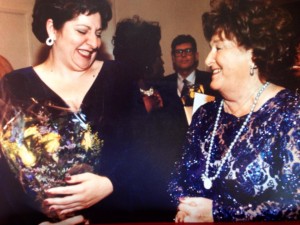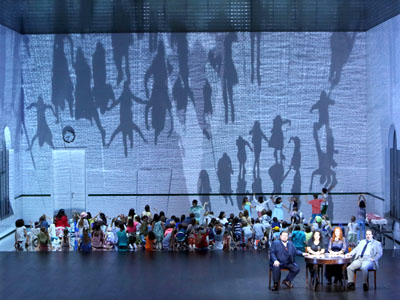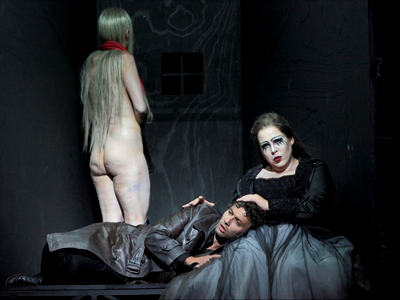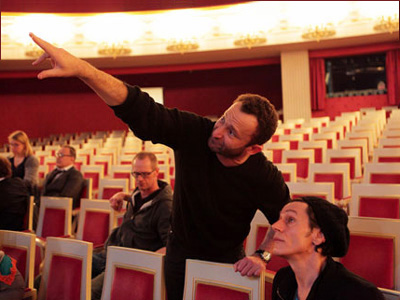by Albert Innaurato
(Christine Goerke congratulated by Birgit Nilsson after winning her competition)
Buttons that should be made from the Met’s Die Frau ohne Schatten: CLONE Christine Goerke. ANNE SCHWANEWILMS FOR ACT THREE. FIRE VLADIMIR JUROWSKI. I thought he rushed through in a business like if technically able way, missing the high romanticism, the “nuss”, which is the only way the very long opera really becomes completely and continually involving.
He forced Goerke (who had a triumph as the Dyer’s Wife) through every soaring phrase — she could have spun them out thrillingly (many can’t), he RUSHED the D major interlude in scene two, act one, (marked “molto sostenuto e cantabile” — VERY MUCH SUNG AND SUSTAINED) — and after that RUSHED Goerke on the low d’s and the phrase starting “und mich dich gemacht”, which includes two low A’s delivered with a contralto’s color and size — and RUSHED the beautiful chorale at the end of that scene. He drowned everyone but Goerke out. In act three, Schwanewilms had the sense to come all the way downstage and do it her way (she had some issues earlier).
He RUSHED the most soaring music in the opera, “Schweigt doch ihr Stimmen”, that opens act three, and did not relish a DYER’S WIFE who could really soar when she joins in the duet with her husband Barak, “Mir anvertraut…”, and ignored one who could actually DO that impossible line all the way up to B natural (in fact tied B flat to HALF NOTE B natural) and then, after the alto says they are free, he RUSHED her through that insane cry of jubilation (and yes I realize it’s marked “LEBHAFT” — “lively”) but you had someone who at the very least DESERVED the opportunity to spin out that final phrase that starts on the high A natural (half note tied to quarter soars up to the B flat tied to quarter and yes I know they become triplets but the music needs grandeur.)
Many of the markings in the score are fast, but fast and flexible, inward and expansive are the way for me and it’s how Wolfgang Sawallisch did it in Munich (I saw him do it 11 times there and saw him rehearse) and how Christian Thielemann does it (complete!). Scuttlebutt from backstage (unconfirmed, of course) was that the Met wanted the usual cuts, Jurowski insisted on the work being given complete but was told he better get a move on.
Audibility issues with others (I was sitting orchestra row M on 11/12), and I thought Barak, Johan Reuter, though he had a pretty tone, was slight and bland, and the Nurse — whose part is impossible to sing, let’s face it, and really cruel if the work is done complete — barely made it.
And, as with Sondra Radvanovsky’s often phenomenally sung Norma, I felt that there was no one to teach the singers how these scenes work best (the brilliant original director, Herbert Wernicke died in 2002). I remember Birgit Nilsson and Dietrich Fischer Dieskau in that D major interlude simply standing still and staring at one another with everything they had in them — the longing the couple feels, the intense attraction, yet the impossibility for them at that moment to express it — was overwhelming (Nilsson and Theo Adam did the same) — it is the magic of filled, focused and felt stillness. Or Fischer Dieskau, terrifying, moving from confusion to homicidal rage at the end of act two, as Nilsson (and the great Inge Borkh on other occasions) abandoned herself to his knife, almost as a kind of sexual/sacrificial offering — stunning and shocking.
A friend, my age, said — “bury the ghosts and seize what’s here”; so CLONE CHRISTINE GOERKE and yes, ANNE SCHWANEWILMS — while she got the better of Jurowski in act three, he did prevent her from really taking that devastating pause before “Du taugst nicht zu mir” to the nurse — I’m not going to mention Leonie Rysanek, Eva Marton, Cheryl Studer, but will mention Ingrid Bjoner who I saw six times in Munich — ALL got to make the MOST of that pause, a HUGE moment of decision.
Jurowski is a tall, young, nice looking Russian with very long hair, doesn’t that mean he’s great? But Thielemann, conducting the entire work live both at the Met, and in Berlin and on a Decca DVD with a good cast, including Schwanewilms found so much more. Sawallisch also does wonderfully on a note complete EMI recording, and old timers may remember the compelling old Zillig recording. I heard it first in high school on reel to reel tape, now, with luck, it’s to be found on Ponto CDs. On that recording, Christa Ludwig, some years later to emerge as a great exponent of The Dyer’s Wife, sings the soprano role of the Falcon!!!
How much Die Frau ohne Schatten is worth as a work of art is a different matter.
Perhaps on my other blog I will consider that. But soon, more on Goerke, announced as the next Brunnhilde in a complete Ring at the Met.
Albert at length:
http://mrsjohnclaggartssadlife.blogspot.com/


![Taiwan_NSO_1[1]](http://www.musicalamerica.com/mablogs/wp-content/uploads/2013/11/Taiwan_NSO_11-150x150.jpg)


